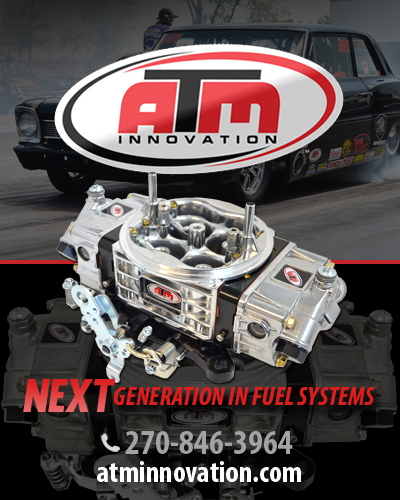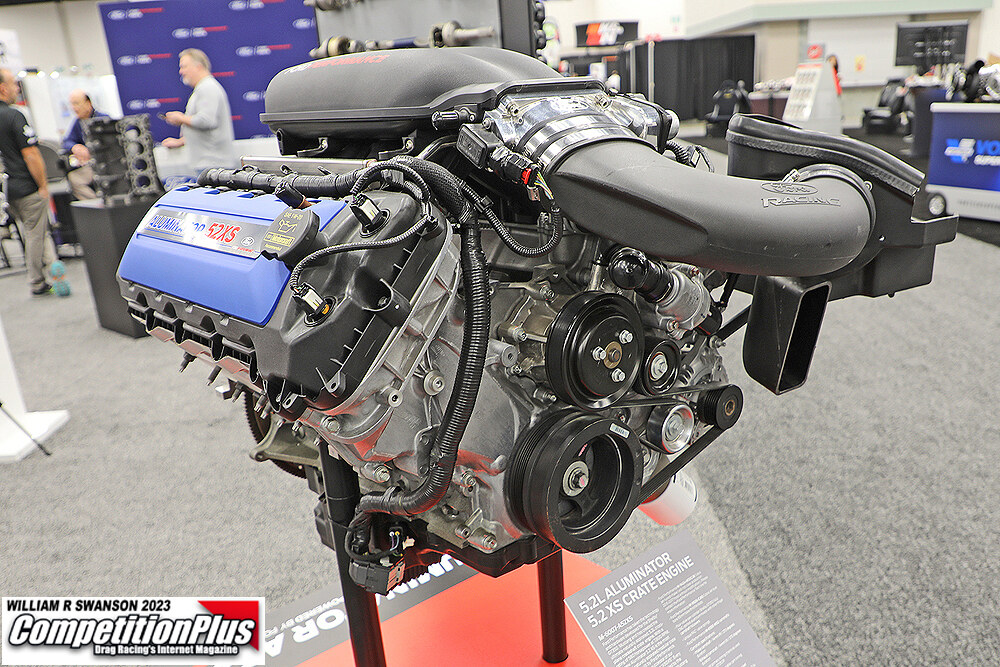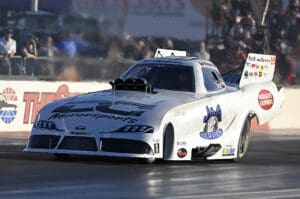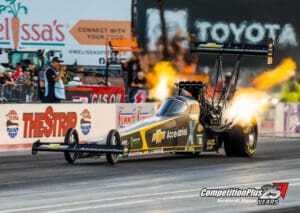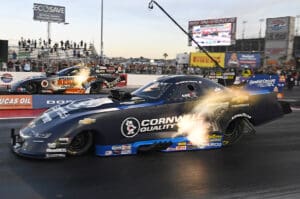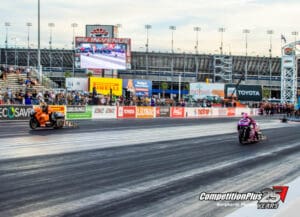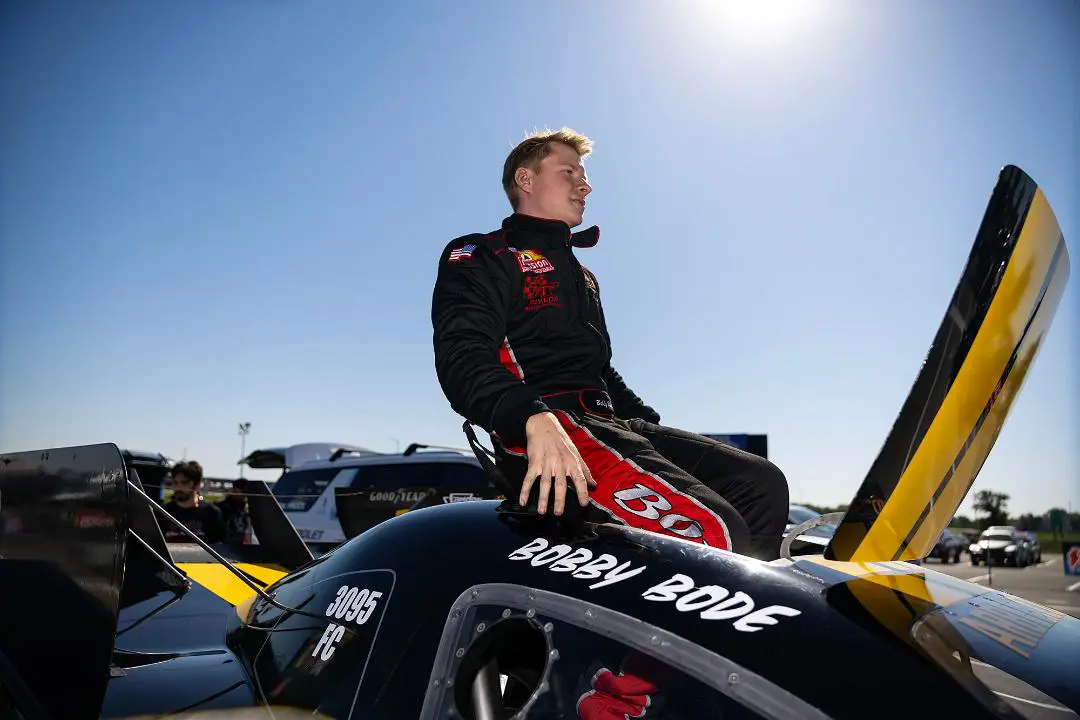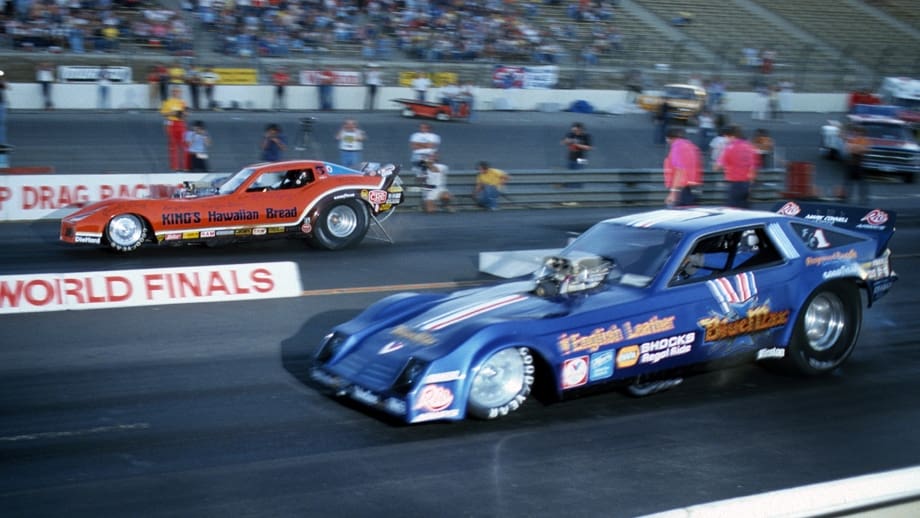 “Double A” Dale Armstrong is widely acknowledged as being one of the
“Double A” Dale Armstrong is widely acknowledged as being one of the
most intelligent individuals to have ever participated in drag racing,
and this is a sport that’s attracted some real geniuses down through
the years. From the first time anyone saw his topless Funny Car to his
all-conquering alcohol dragsters to his unprecedented accomplishments
as a tuner, no one has ever questioned Armstrong’s ability to recognize
a problem and then overcome it.
Along with countless championships – some won on his own, many others
on behalf of Kenny Bernstein – Armstrong is correctly credited with the
development of so many things racers today take for granted. One, of
course, is the on-board computer system, but there are dozens more.
Other innovative ideas proved too daunting to NHRA officials and were
outlawed on the grounds of potentially being too costly, or in
producing cars that were simply too fast for the tracks upon which they
raced. Among those concepts was a three-spark-plugs-per-cylinder
magneto and cylinder head configuration and a two-speed supercharger.
Drag
Racing’s Most Honored Tuner May Have The Right Answer, But Will NHRA Listen?

In 1997 Armstrong submitted a six-page paper to the NHRA outlining a plan for slowing the cars down, but after some testing and discussion with other tuners – most of whom rejected it out of hand without explanation – it was not adopted. (Jon Asher Photo)
“Double A” Dale Armstrong is widely acknowledged as being one of the most intelligent individuals to have ever participated in drag racing, and this is a sport that’s attracted some real geniuses down through the years. From the first time anyone saw his topless Funny Car to his all-conquering alcohol dragsters to his unprecedented accomplishments as a tuner, no one has ever questioned Armstrong’s ability to recognize a problem and then overcome it.
Along with countless championships – some won on his own, many others on behalf of Kenny Bernstein – Armstrong is correctly credited with the development of so many things racers today take for granted. One, of course, is the on-board computer system, but there are dozens more. Other innovative ideas proved too daunting to NHRA officials and were outlawed on the grounds of potentially being too costly, or in producing cars that were simply too fast for the tracks upon which they raced. Among those concepts was a three-spark-plugs-per-cylinder magneto and cylinder head configuration and a two-speed supercharger.
Like any good tuner/crew chief, Armstrong also had a knack for pushing that so-called envelope, with one of those exercises being what became known as the “Batmobile” Buick with which Bernstein won a title. Rather than risk NHRA banning the radically modified Reatta at first glance, Armstrong showed it to them while it was still in gray primer, sitting on the floor of the shop. The windows hadn’t even been cut out yet, as it was fresh out of the mold. In that condition it looked at least reasonable, so it was approved. When it finally appeared on the track it was too late to ban it, proving once again that a master crew chief is often sharper than those charged with keeping him in check.
Among Armstrong’s personal honors were no less than 11 appearances on the Car Craft Magazine All-Star Drag Racing Team in five separate categories, including the prestigious Ollie Award. That one’s emblematic of an individual’s career-long contributions to drag racing. He’s also an Inductee in the International Drag Racing Hall of Fame and is also a member of the Canadian Motorsports Hall of Fame. Few individuals have stronger credentials than Armstrong when it comes to understanding what makes a race car work, and what might work to slow it down without detracting from drag racing’s excitement.
In 1997 Armstrong submitted a six-page paper to the NHRA outlining a plan for slowing the cars down, but after some testing and discussion with other tuners – most of whom rejected it out of hand without explanation – it was not adopted. Since then Armstrong has solidified his thinking, and shared his views with CompetitionPlus.com in an exclusive interview that took place the day following the announcement by NHRA that the race distance for fuel cars would be shortened to 1,000 feet.
a d v e r t i s e m e n t
Click to visit our sponsor’s website
CompetitionPlus.com: We’ll throw out some ideas on how to slow the cars down, and you shoot them down as either impractical or just plain stupid! What about a restrictor plate between the injector and the supercharger that would curtail airflow into the engine. If you don’t have the air, you can’t burn it.

During the Summit Racing Equipment Nationals Funny Car driver Del Worsham, in anticipation of rules changes and/or a shortening of the race distance, suggested that almost any alteration in the then-current set-up could be circumvented. After hearing Armstrong’s outline we asked Worsham if he still felt that way.
DA: The way to circumvent that is to turn the blower faster. That way you’ll create more of a vacuum under the plate, and pull more air through it. The way those work in NASCAR is that there’s no force-feeding the engine, so it works. The air isn’t being sucked into the engine in drag racing, it’s being forced in by the blower. The faster you can turn the blower, the more air will be sucked into the engine. The other thing is that if you did that it would completely destroy the fuel delivery configuration as we now know it. Everyone would have to start over, from scratch, and there’d be a lot of failures until the guys got it right. The other thing is the guys would up the compression ratio even more than it is now. What would happen is that you’d eventually get back to the same operating pressures that are in the engines now.
CP: How about restricting the output of the fuel pumps, or even limiting it to a single pump?
DA: If you put a smaller fuel pump on the engine all it will do is pull the motor down in the middle of the course. What happens is that as the motor slows down because the clutch is pulling it down, the fuel pump slows down, too. You’d have horrendous heat conditions out in the middle of the course because there’d be less fuel in the motor to cool things down.
Right now the guys have those slide valves in the fuel system to put more and more fuel into the motor as it slows down. When the motor starts coming back up again in rpm they start bleeding that fuel back off again because the motor starts losing Volumetric Efficiency. That’s why you’ve got to have a pump that’s big and flows a lot of fuel. Without that big pump it would be tremendously hard on the motor, and that means more parts destruction and failures of bearings, rods and pistons. It sounds like a simplistic solution, but ultimately it would end up costing more in parts to do that.
CP: Your basic plan for slowing the cars down is a strict limit on compression ratio, isn’t it?
DA: Yes. In my opinion NHRA should find some cars they can work with, maybe one of each in Top Fuel and Funny Car, and all it would take would be about two days of work to prove this plan out. What NHRA needs to do first is decide what they want as a maximum performance figure, and then work towards that with these cars. Then all they’d have to do is work with two things. Let’s say that they decide, hypothetically, that they want a static compression ratio of 6:1.
You’d
have to lower the compression ratio and slow down the blower overdrive…and
there’s no way the racers would be able to circumvent it.
CP: What’s the static compression ratio on most of the cars now?
DA: I’d say it’s right at 7:1 or 7.2:1. They’ve made big advancements in compression ratios lately. When I was out there with Jerry Tolliver last year, if we had that car going across the finish line with all the cylinders lit it would have between 65 and 70 lbs. of blower boost. Think about what that kind of pressure is like inside an intake manifold. When you’re compressing the air like that it creates a lot of heat. The only way to get that heat out of the air is to have it absorbed by the fuel. That heat has to go somewhere, so it’s absorbed by the fuel, so you have this mixture going into the cylinders that is damn hot. When we first started talking about lowering speeds 11 years ago I told the guys that I knew they’d circumvent the rule by upping the compression ratio and speeding up the blower. I never thought it would get worse than it was then, but it has. NHRA finally stopped the blower overdrive situation at 50 percent over.
CP: Would you advocate lowering the blower overdrive even more along with a compression ratio rule?
DA: Yeah, you have to do both. They go hand in hand with each other.
CP: Is there anything else that would have to be done, or are these two simple steps enough to slow the cars?
DA: You wouldn’t have to do anything else, and there’s no way the racers would be able to circumvent it.
a d v e r t i s e m e n t
Click to visit our sponsor’s website
CP: Haven’t you already done some experimentation along these lines some years ago?

All it would take to switch over to this is more pulleys to slow the blower down, and pistons, and they buy those by the hundreds right now. Some of ‘em buy ‘em by the thousands!
DA: Yes. It was right before I’d agreed to go to work for Snake (Don Prudhomme) in 1997. This was right after I’d submitted the paper to NHRA, and they called me about it. We had a conference call with about 12 people, including Dallas Gardner. After that Graham called me and said they were going to try it.
On the Monday after the Dallas race that year we stayed and tested things with Dixon’s car. I’d bought a bunch of pistons that would lower the compression ratio the way I thought it should be. The car was still the way it was as they’d raced it over the weekend. All we did was set it up with about 6:1 compression. We started with the blower 35 (percent) over. It went right down through there, but it might’ve dropped a cylinder, so we took it all apart to check it, and it looked perfect. It looked better than an alcohol motor. We made another run and it ran about 4.80 at 290 mph, and again it had some cylinders out near the (top) end. We made a third run and the exhaust valves were looking gray. That was an indication that the engine had slow burn because it had so much less volume of air at TDC (Top Dead Center). We put about four degrees more lead in it and juggled a couple of cylinders (for better fuel delivery). On the last run it went 4.77 at 299 or ’98 ‘cause it still dropped a hole at about 1,000 feet.
We took the motor apart after each run, and I’m telling you, without any stretch of the imagination, or any stretch of the truth at all, that by today’s standards it looked way better than an alcohol car’s motor. It hurt absolutely nothing. Nothing. You can ask (Ken) Veney, (Wes) Cerny, any of ‘em that were there. It looked perfect.
So anyway…there were maybe four other Top Fuel dragsters there, (and) there was only one car that went quicker than us, and that was Bernstein, and he ran a ‘seventy-two.
Afterwards Graham (Light) called me back and told me (NHRA) was going (to adopt the low compression rule). But, when they told some of the racers they were going to do it, there was just a rash of protests, so NHRA decided not to do it. They said they were going to table it for more discussion.
After the season was over someone came up with the idea of taking some of the nitro out of the cars, which worked fine for a little bit. Then they all kicked the compression ratio up to make up for the lost nitro and they started hurting more parts than ever before. They all simply circumvented the (nitro) rule by upping the compression ratio. That was their way of getting around it.
I pointed out that (NHRA) needed to do something right then to keep the cars right around 300 mph.
Look, with this thousand foot deal all these guys are going to do is turn things up so they blow up at 800 feet. That’s no good. It’s not going to be any safer, and it’s going to cost just as much money. It just doesn’t work. I applaud NHRA for doing it in the short term. It shows the fans they’re trying to do something, but it shouldn’t be permanent, and they should find another solution.
a d v e r t i s e m e n t
Click to visit our sponsor’s website
CP: Why do you think there was such resistance to this concept by the other tuners?
DA: I don’t know. I’ve spoken to the guys about this over the years, and I just don’t know. There’s no downside to it at all. It would save them so much money, and it would increase the margin of safety dramatically. Like I told Alan (Johnson), “You know, the guys that are out here running good and winning are still going to be the winners. The smart guys are still going to be the ones that come out ahead.” This plan isn’t going to make it like slot car racing, where everybody can win. The smart guys will really excel because they’ll get into things like camshaft timing, more cylinder head flow and things like that. It’ll make it more of a finesse game, and the smart guys will still be the winners. It isn’t going to give some guy that isn’t on (the level of Johnson, Austin Coil, etc.) any kind of advantage. In my opinion it gives the smart guys an advantage.
You know, some of the guys were moaning about how they’d have to buy all these pistons and things, so I said, “Wait a second. You buy hundreds of pistons right now anyway. You buy head gaskets at five thousandths of an inch increments.” Right now it’s astonishing how many head gaskets these guys buy, and they buy ‘em in thousandth of an inch increments. That’s crazy. The costs are astronomical. They’ve got drawers full of ‘em.
Now, if they alter compression ratios by the thousandth of an inch, are you telling me they couldn’t maintain a legal (lower) compression ratio even easier?
All it would take to switch over to this is more pulleys to slow the blower down, and pistons, and they buy those by the hundreds right now. Some of ‘em buy ‘em by the thousands!
If
any racer says he can get around this, have ‘em call me and I’ll blow ‘em out
of the water, because I’ve been thinking about this for 10 years.
CP: It’s our understanding that NHRA tried to hire you when Ray Alley left. Is that true?
DA: They tried to hire me a while back, but I just never had any interest in it. Technically I could do the job, but I’m not a guy who likes to do a lot of paperwork and get in beefs with guys that are my friends. I think this takes a totally different approach, in my opinion. They need someone along the lines of how old Jack Hart was (a long-since deceased NHRA executive known for his in-your-face, take-no-prisoners manner. – Ed.) When he said something, you did it.
Right now none of the guys out there have any respect for the tech people because they know they can get away with things. I knew when I was out there I knew I could get away with things big time.
I think you’ve got to have someone who dictates to these guys, who isn’t afraid of confrontation, who’d say to someone who gave ‘em grief, all you’d have to say one time is “Pack up your stuff and get out of here.” You’d only have to do it once, and it would never happen again.
I think the guy who could do that job is Dave Settles. He’s incredibly sharp, and doesn’t mind speaking his mind on things. He’d get in your face, and he’s a technical guy. He told me last year that he’d talk to NHRA about it if they ever offered him the job.
a d v e r t i s e m e n t
Click to visit our sponsor’s website
CP: We’ve heard that NHRA believes they don’t have anyone capable of checking things like compression ratio and the like. How difficult is it to check these things?
DA: Now, wouldn’t you be embarrassed if that was the case? You could take anyone, someone like me, or Ken Veney, anyone who knows this stuff and in a single afternoon you could train a few guys to do this. It’s simple and easy to check. It’s not complicated at all. Al they’d have to do is make some random checks, maybe the Low E.T. car, or after the race, maybe the winner’s car. What they would have to do, of course, is to make the penalty for cheating so severe that nobody would even entertain the thought of doing it. I don’t mean money, because that would hurt the little guys. If someone were found cheating they’d immediately be disqualified from that event, but you’d also lose the points from the (next) two or three races. Anyone who was seriously contending for the championship, well, that would put them completely out of contention for the year. You could still go to the races and run for the money and your sponsors, but you wouldn’t get any points. Who would cheat under those rules? No one.
Say you were caught cheating at (the Winternationals). Well, you’d be out of it even before the year began, and nobody’s going to take that chance.
With a compression ratio and blower overdrive rule it’s so simple, so easy to police, and there’s just no way the racer can circumvent it without cheating.
I’ve asked guys like Alan Johnson what he would do if they made this a rule, and he said, “Well, I’d put more (ignition advance) in it.” And you would, because when you first started doing this the motor would look “soft,” so you’d put more lead in it until you reached the point of diminishing returns, and you’d go back to where you felt that was the most lead you could put in it. You don’t just automatically gain more horsepower by putting more lead in the engine. There’s finally an end to that, or it starts hurting parts, so putting lead into it isn’t the answer.
If any racer says he can get around this, have ‘em call me and I’ll blow ‘em out of the water, because I’ve been thinking about this for 10 years. There is just no way of getting around (this kind of rule).











